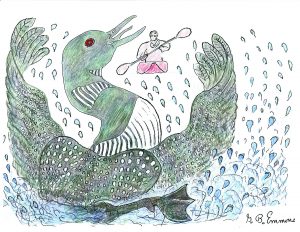As a birdwatcher, one sight to remember is one of a common loon in the backwaters of our freshwater lakes or ponds. And there is good news of a gradual increase in the New England population as reported by The Loon Preservation Committee of Lake Winnipesaukee, New Hampshire.
As an independent conservation organization with an annual mid-Summer count, the preservation committee has documented a greater number of sightings of adult pairs carrying chicks on their backs. It has been successful in creating and protecting more nesting sites by introducing artificial floating wooden platforms where needed. Their main accomplishment, however, is to inform and educate the public the importance of quiet placid water habitat to protect the nesting sites by keeping their distance from traditional locations of annual reproduction.
The nest of a loon is never more than a few feet from the water because, evolving from dinosaurs with amphibian ancestry, their legs similarly are so far back in their body frames as to be unable to stand up or walk on land. Nesting privacy and peace of mind are essential to successful hatching and rearing of only the usual two chicks, so the parents get visibly upset at any approach of intruders. Their defensive reaction is to rush out from the nest, standing up in the water frantically flapping their wings to splash everywhere in a frightening feathery warning. This gives the appearance of getting the title of ‘dancing on the water,’ as in my illustration.
This aquatic feathery display of anger is to protect and defend the offspring and is accompanied by an alarming angry high-pitched yodel of antagonism called a tremolo. The parent with the excited tremolo can get so worked up that if the intruder does not go away, the end result can be a seizure and death. Such heroic, martyr-like acts of protection are similar to the partridge and killdeer plover, for example, feigning a broken wing and flopping down before a predator to draw attention away from fledglings.
The loon also has another unforgettable communication. It is a wail especially vibrant when heard by lakeside campers in the closing quiet of the day. It is to locate other loons along the shoreline and sounds like, “ Where are you,“ as if in the mood for a little closing-day company.
Henry David Thoreau at Walden Pond as one of the first transcendentalists said that the wail of the loon was one of the most unearthly sounds he had ever heard. And to the lake country Penacook Indians of Lake Winnipesaukee, so in tune nature, a frequent atmospheric variation in the wavering tone could be detected as a weather prediction of impending rain.
Loons also have a third call of a short guttural squawk when they talk quietly amongst themselves and their offspring. When nature talks, I hope you enjoy with me my inclination to stop, listen, and learn to appreciate the message conveyed.
By George B. Emmons
